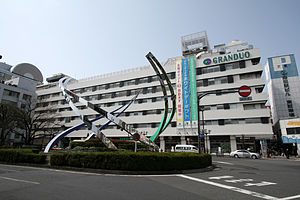Kamata Station (Tokyo)
35°33′43.20″N 139°42′55.92″E / 35.5620000°N 139.7155333°E
Kamata Station 蒲田駅 | |
|---|---|
 Station building, March 2010 | |
| General information | |
| Location | Ōta, Tokyo Japan |
| Operated by | JR East, Tokyu Corporation |
| Line(s) | |
| Connections |
|
| History | |
| Opened | 1904 |
| Passengers | |
| JR East, FY2013 | 139,728 daily |
Kamata Station (蒲田駅, Kamata-eki) is a railway station in Ōta, Tokyo, Japan, operated by East Japan Railway Company (JR East) and the private railway operator Tokyu Corporation.
Lines
Kamata Station is served by the following lines:
Keikyu Kamata Station on the Keikyu Main Line is located about 700 m to the east of Kamata Station.
Station layout
JR East
The JR East station is a surface station with platforms in a north-south direction.
Platforms
| 1-2 | ■ Keihin-Tohoku Line | for Kawasaki, Yokohama, and Ōfuna |
| 3-4 | ■ Keihin-Tohoku Line | for Shinagawa, Tokyo, and Ōmiya |
Tokyu

The Tokyu station is located to the southwest corner of the JR station.
Platforms
| 1 | ■ Tokyu Ikegami Line | for Ikegami, Yukigaya-Ōtsuka, Hatanodai, and Gotanda |
| 2 | ■ Tokyu Ikegami Line | for Ikegami, Yukigaya-Ōtsuka, Hatanodai, and Gotanda |
| ■ Tokyu Tamagawa Line | for Shimo-Maruko and Tamagawa | |
| 3-4 | ■ Tokyu Tamagawa Line | for Shimo-Maruko and Tamagawa |

Adjacent stations
| « | Service | » | ||
|---|---|---|---|---|
| Keihin-Tōhoku Line | ||||
| Tokyo | Rapid | Kawasaki | ||
| Ōmori | Local | Kawasaki | ||
| Tokyu Ikegami Line | ||||
| Hasunuma | - | Terminus | ||
| Tokyu Tamagawa Line | ||||
| Yaguchinowatashi | - | Terminus | ||
History
The JR East station opened on 11 April 1904.[1] The Tokyu station opened on 6 October 1922 on the Ikegami Line, and services on Tamagawa Line began on 1 November 1923.[2]
Future plans
Plans exist to extend the Tokyu Tamagawa Line from Kamata eastward by approximately 800 m to Keikyu Kamata Station on the Keikyu Main Line and Keikyu Airport Line. This would provide an interchange between the lines, improving accessibility to Tokyo's Haneda Airport ahead of the 2020 Summer Olympics.[3]
Passenger statistics
In fiscal 2013, the JR East station was used by an average of 139,728 passengers daily (boarding passengers only), making it the nineteenth-busiest station operated by JR East.[4] Over the same fiscal year the Tōkyū Ikegami and Tamagawa Line stations were used by an average of 69,464 and 88,102 passengers daily respectively (entering and exiting passengers).[5]
The passenger figures for previous years are as shown below.
| Fiscal year | JR East | Tōkyū | |
|---|---|---|---|
| Ikegami Line | Tamagawa Line | ||
| 2000 | 129,724[6] | ||
| 2005 | 131,947[7] | 64,664[8] | 82,890[8] |
| 2010 | 133,748[9] | 67,873[10] | 84,399[10] |
| 2011 | 133,593[11] | 67,171[12] | 84,269[12] |
| 2012 | 135,668[13] | 68,143[14] | 85,300[14] |
| 2013 | 139,728[4] | 69,464[5] | 88,102[5] |
- Note that JR East figures are for boarding passengers only.
References
- ^ 日本国有鉄道停車場一覧. Japan: Japanese National Railways. 1985. p. 19. ISBN 4-533-00503-9.
{{cite book}}: Unknown parameter|trans_title=ignored (|trans-title=suggested) (help) - ^ Terada, Hirokazu (19 January 2013). データブック日本の私鉄. Japan: Neko Publishing. p. 231. ISBN 978-4-7770-1336-4.
{{cite book}}: Unknown parameter|trans_title=ignored (|trans-title=suggested) (help) - ^ "Rail extension eyed to boost Haneda accessibility". The Japan Times. Japan: The Japan Times Ltd. 29 July 2014. p. 7. Retrieved 29 July 2014.
- ^ a b 各駅の乗車人員 (2013年度) (in Japanese). Japan: East Japan Railway Company. Retrieved 2 September 2014.
{{cite web}}: Unknown parameter|trans_title=ignored (|trans-title=suggested) (help) - ^ a b c 2013年度乗降人員 (in Japanese). Japan: Tokyū Corporation. 4 June 2014. Retrieved 2 September 2014.
{{cite web}}: Unknown parameter|trans_title=ignored (|trans-title=suggested) (help) - ^ 各駅の乗車人員 (2000年度) (in Japanese). Japan: East Japan Railway Company. Retrieved 2 September 2014.
{{cite web}}: Unknown parameter|trans_title=ignored (|trans-title=suggested) (help) - ^ 各駅の乗車人員 (2005年度) (in Japanese). Japan: East Japan Railway Company. Retrieved 2 September 2014.
{{cite web}}: Unknown parameter|trans_title=ignored (|trans-title=suggested) (help) - ^ a b 2005年度乗降人員 (in Japanese). Japan: Tokyū Corporation. 19 May 2006. Retrieved 2 September 2014.
{{cite web}}: Unknown parameter|trans_title=ignored (|trans-title=suggested) (help) - ^ 各駅の乗車人員 (2010年度) (in Japanese). Japan: East Japan Railway Company. Retrieved 2 September 2014.
{{cite web}}: Unknown parameter|trans_title=ignored (|trans-title=suggested) (help) - ^ a b 2010年度乗降人員 (in Japanese). Japan: Tokyū Corporation. 19 May 2011. Retrieved 2 September 2014.
{{cite web}}: Unknown parameter|trans_title=ignored (|trans-title=suggested) (help) - ^ 各駅の乗車人員 (2011年度) (in Japanese). Japan: East Japan Railway Company. Retrieved 2 September 2014.
{{cite web}}: Unknown parameter|trans_title=ignored (|trans-title=suggested) (help) - ^ a b 2011年度乗降人員 (in Japanese). Japan: Tokyū Corporation. 15 May 2012. Retrieved 2 September 2014.
{{cite web}}: Unknown parameter|trans_title=ignored (|trans-title=suggested) (help) - ^ 各駅の乗車人員 (2012年度) (in Japanese). Japan: East Japan Railway Company. Retrieved 2 September 2014.
{{cite web}}: Unknown parameter|trans_title=ignored (|trans-title=suggested) (help) - ^ a b 2012年度乗降人員 (in Japanese). Japan: Tokyū Corporation. 29 May 2013. Retrieved 2 September 2014.
{{cite web}}: Unknown parameter|trans_title=ignored (|trans-title=suggested) (help)
